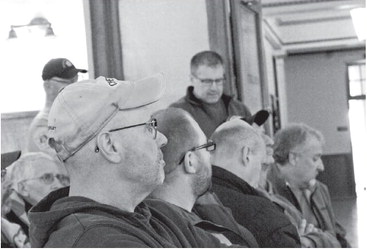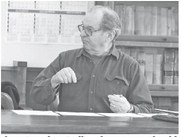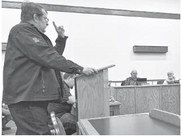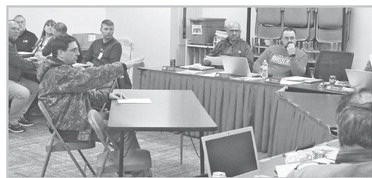Hunters voice opposition to DMAP in county forest
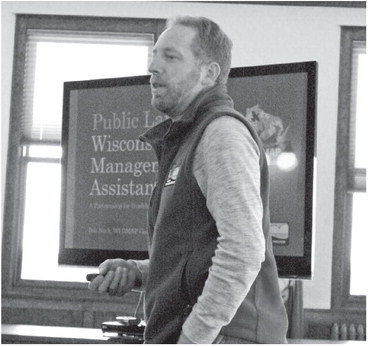

Hunters criticize county for subverting county deer advisory council’s authority
A proposal to create a Deer Management Assistance Program (DMAP) zone in the Taylor County forest met with a frosty reception from area hunters at the December 6 meeting of the county’s forestry and recreation committee.
Bob Nack, the Department of Natural Resources’s state coordinator for DMAP program was at the meeting to give a presentation on what it is and how it could be used in Taylor County to help manage deer in the forest.
DMAP has been around since 2014 and has been almost exclusively used on private land to work to improve deer management practices. According to Nack the program has been a popular one around the state with Taylor County having a number of private land DMAPs in place.
One of the key components of DMAPs is the ability to set the tag limits on that specific area to manage it to a level beyond what is set by the local County Deer Advisory Council (CDAC).
Under a DMAP zone, the CDAC would have first say to set the quote, but DMAP working with the land owners and wildlife biologists could refine that for the specific zone.
Brian Bucki said that while he thinks the DMAP is a good program, it is something he feels belongs in the private sector. He expressed concern about it being abused on public lands to undermine the CDAC’s ability to manage populations.
Bucki said a lot of the county’s efforts are due to concerns about damage to reforestation areas following logging. He said the Taylor County CDAC has taken the county’s concerns seriously and incorporated them within their quota recommendations for public lands.
Bucki said that in his profession as a taxidermist, he talks to hundreds of hunters each year and has also talked with numerous loggers none of whom were concerned by what the county cites as excessive deer damage. He also reported on talking with other foresters who have different opinions about the impact of the browsing and the number of deer per mile in the forest feeling the population could be much higher without hurting the deer population.
For hunter Jeff Thums, the problem is not with too many deer in the county forest, but too few deer. Other hunters raised concern with what they saw as the overall mismanagement of the county forest including how cuts were handled and the use of a scarification process for oak regeneration.
CDAC member Chip Courtney brought it back to the role of the CDAC in the county. He said the CDAC includes a wide variety of stakeholders and receives a lot of public input. He objected to carving the county forest out of that process. “I see no reason that we would abandon the process and segregate a critical part of the purview in a separate unit,” Courtney said. He said the DMAP would exclude the CDAC from the process, which he said was bad policy for public lands.
“I don’t see any reason to antagonize taxpayers,” Courtney said.
Resident Mike Riggle raised concerns with the county encouraging hunters from outside the area to hunt in the forest. “Why would you advertise this?” he asked.
Forest administrator Jake Walcisak reported that he had only issued a release to The Star News and that other media had picked up on it on their own.
Of the bonus tags issued in the county forest this season, only three deer had been bagged as of the meeting.
“I don’t believe there should be extra tags in that area,” said resident Chuck Gelhaus reporting that hunting has gone downhill in the county forest area in recent years. Gelhaus, like many of those at the meeting had land adjacent to the county forest.
A hot point in the discussion centered on control. With both the county and the CDAC committee members both concerned about ceding control to the other when it comes to managing the deer population in the area. Walcisak said the CDAC is and always has been an advisory committee. “The DNR has maintained control and they have never lost control of the deer herd,” he said, questioning how people can support DMAPs on private land but not public land.
Riggle said that the DNR lost the ability to manage private lands long ago and that DMAP zones allow them to regain some management ability. He said this differs from public land which are held in the public trust and are open to everyone.
After more than an hour of comments, Zenner cut off additional comments so the committee could move on with its agenda. No action was scheduled to take place in regard to a potential DMAP zone in the forest and the presentation was for information only at this time.
Zenner suggested there is room for compromise between those who want additional deer in the county forest and those concerned about the impact of over browsing on regeneration. He said while neither side may get entirely what they want, they could work together.
Chelsea Dam
Taylor County will be seeking a second opinion when it comes to comparing the costs of competing estimates for the planned replacement of the Chelsea Lake Dam.
At a previous meeting, committee members expressed concern over why the Ayres Associates estimate for the replacement of the Chelsea Lake Dam was so much more than one prepared by Flambeau Engineering.
The Ayres estimate for the project was $200,000 compared to about $50,000 from Flambeau Engineering. At Friday’s meeting. Walcisak presented a side-byside comparison of the two estimates.
A large reason for the difference in price was the differing project parameters given to each of the firms. While Flambeau Engineering was told to replace what was there with a similar structure, Ayres was given direction for an entirely new water control structure in addition to installing additional equipment as part of the project.
Flambeau Engineering’s estimate on replacing the existing water control structure with an identical structure with corrugated metal pipes and manual stop logs was $19,500. By comparison Ayres estimate for a completely different structure including a concrete drop inlet, 48-inch concrete pipe, drawdown gate hoist, steel grating and handrail was $51,080. This upgrade also resulted in additional expenses such as extending the downhill slope at $20,000, the installation of a filter and diaphragm for $20,000, $9,000 in additional site restoration and significant increases in the dewatering, mobilization and dewatering.
Because the Ayres estimate was a bigger overall project it also carried a larger contingency with the Flambeau Engineering contingency at 10% or $4,495 while Ayres was at 25% or $39,276.
“We would like a significantly different structure,” Walcisak said. He said they were looking for something that was more secure from tampering and safer to operate. He described the current process of adjusting the water level as being a two-person job where one person is holding the other’s ankles as they crouch over a 6-foot hole.
Walcisak said there is also a difference in the project longevity of the two options. While the Flambeau Engineering proposal was estimated to result in a structure that would be good for 40 years, the Ayres structure has an estimated lifespan of 80 years.
Given the cost of the project, committee member Gene Knoll said he felt they should have a more detailed, “apples to apples” comparison of the two estimates.
Anticipating this, Walcisak had contacted Oak Creek Engineering who agreed to do the comparison for a cost of $1,400. Committee members approved hiring Oak Creek Engineering to do the comparison.
In other business, committee members, approved awarding logging bids for multiple projects totaling 630 acres and having a combined bid value of $755,000. This included one project that was a rebid from a bid taken back by the county. Each year the county logs approximately 3% of the forest. Unlike other counties in the state, Taylor County was able to see bidders for all of the projects with some of the bid values coming in at more than double the minimum bid amounts.

